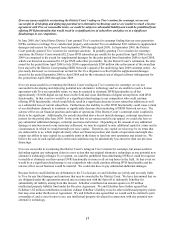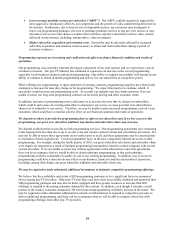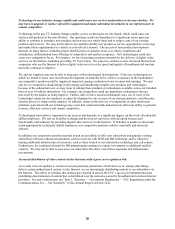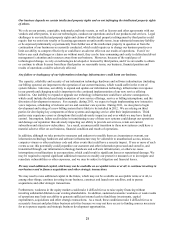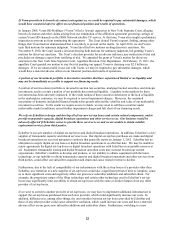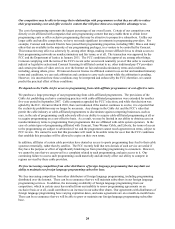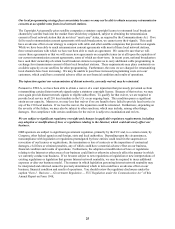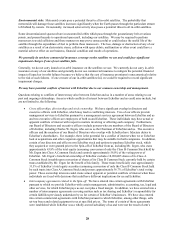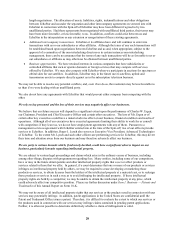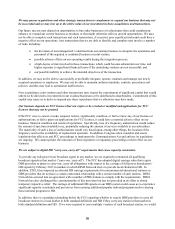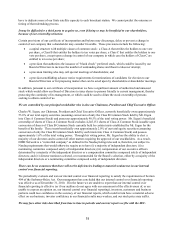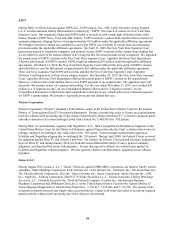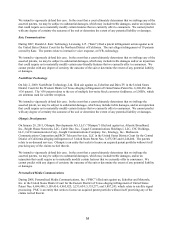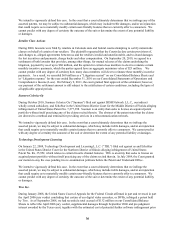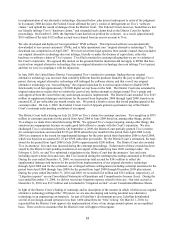Dish Network 2010 Annual Report Download - page 34
Download and view the complete annual report
Please find page 34 of the 2010 Dish Network annual report below. You can navigate through the pages in the report by either clicking on the pages listed below, or by using the keyword search tool below to find specific information within the annual report.27
27
construction, the durability of their component parts, the ability to continue to maintain proper orbit and control over
the satellite’s functions, the efficiency of the launch vehicle used, and the remaining on-board fuel following orbit
insertion. Generally, the minimum design life of each of our satellites ranges from 12 to 15 years. We can provide
no assurance, however, as to the actual useful lives of the satellites. Our operating results could be adversely
affected if the useful life of any of our satellites were significantly shorter than 12 years from the launch date.
In the event of a failure or loss of any of our satellites, we may need to acquire or lease additional satellite capacity
or relocate one of our other satellites and use it as a replacement for the failed or lost satellite, any of which could
have a material adverse effect on our business, financial condition and results of operations. Such a failure could
result in a prolonged loss of critical programming or a significant delay in our plans to expand programming as
necessary to remain competitive. A relocation would require FCC approval and, among other things, a showing to
the FCC that the replacement satellite would not cause additional interference compared to the failed or lost satellite.
We cannot be certain that we could obtain such FCC approval. If we choose to use a satellite in this manner, this
use could adversely affect our ability to meet the operation deadlines associated with our authorizations. Failure to
meet those deadlines could result in the loss of such authorizations, which would have an adverse effect on our
ability to generate revenues.
Our owned and leased satellites are subject to construction, launch, operational and environmental risks that
could limit our ability to utilize these satellites.
Construction and launch risks. A key component of our business strategy is our ability to expand our offering of
new programming and services, including increased local and HD programming. To accomplish this goal, we need
to construct and launch satellites. Satellite construction and launch is subject to significant risks, including
construction and launch delays, launch failure and incorrect orbital placement. Certain launch vehicles that may be
used by us have either unproven track records or have experienced launch failures in the recent past. The risks of
launch delay and failure are usually greater when the launch vehicle does not have a track record of previous
successful flights. Launch failures result in significant delays in the deployment of satellites because of the need
both to construct replacement satellites, which can take more than three years, and to obtain other launch
opportunities. Significant construction or launch delays could materially and adversely affect our ability to generate
revenues. If we were unable to obtain launch insurance, or obtain launch insurance at rates we deem commercially
reasonable, and a significant launch failure were to occur, it could have a material adverse effect on our ability to
generate revenues and fund future satellite procurement and launch opportunities.
In addition, the occurrence of future launch failures may delay the deployment of our satellites and materially and
adversely affect our ability to insure the launch of our satellites at commercially reasonable premiums, if at all.
Please see further discussion under the caption “We generally do not have commercial insurance coverage on the
satellites we use and could face significant impairment charges if one of our satellites fails” below.
Operational risks. Satellites are subject to significant operational risks while in orbit. These risks include
malfunctions, commonly referred to as anomalies, that have occurred in our satellites and the satellites of other
operators as a result of various factors, such as satellite manufacturers’ errors, problems with the power systems or
control systems of the satellites and general failures resulting from operating satellites in the harsh environment of
space.
Although we work closely with the satellite manufacturers to determine and eliminate the cause of anomalies in new
satellites and provide for redundancies of many critical components in the satellites, we may experience anomalies
in the future, whether of the types described above or arising from the failure of other systems or components.
Any single anomaly or series of anomalies could materially and adversely affect our operations and revenues and
our relationship with current customers, as well as our ability to attract new customers for our multi-channel video
services. In particular, future anomalies may result in the loss of individual transponders on a satellite, a group of
transponders on that satellite or the entire satellite, depending on the nature of the anomaly. Anomalies may also
reduce the expected useful life of a satellite, thereby reducing the channels that could be offered using that satellite,
or create additional expenses due to the need to provide replacement or back-up satellites. You should review the
disclosures relating to satellite anomalies set forth under Note 7 in the Notes to the Consolidated Financial
Statements in Item 15 of this Annual Report on Form 10-K.


